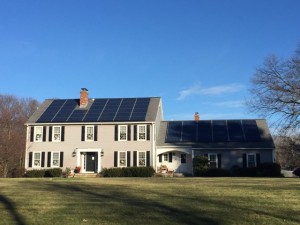 Shortly after placing my order for my Tesla Model S I started looking into installing a solar panel system at home as a way to offset the soon-to-be increased electricity bill. My research turned me to a SolarCity system which I ended up signing up with in April of 2014.
Shortly after placing my order for my Tesla Model S I started looking into installing a solar panel system at home as a way to offset the soon-to-be increased electricity bill. My research turned me to a SolarCity system which I ended up signing up with in April of 2014.
After a number of scoping, design, and utility company challenges the day finally came for installation.
Sizing the Job
While I had originally hoped for a much larger system, the system that was installed was still large by most people’s standards. The final design called for 70 panels, each capable of generating 255W for a total of 17.8 kW and an annual expected output of 18,611 kWh.
To put that into perspective, my Model S uses an average of 775 kWh (as measured through a digital submeter) or approximately 2,400 miles. That usage will climb a bit for the winter months, but I still intend to use about 9,300 kWh per year for my Model S which equates to 50% of my expected solar generation capacity.
What this means is that I’ll be driving my Model S on 100% solar generated energy and still have solar energy to spare to offset my normal electric costs.
Many installations are half this size or smaller due to a number of constraints. Because of the size of this job, SolarCity booked 2 days for the install and sent a crew of about 8 to do the work.
Scheduling
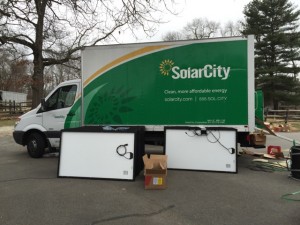 It was a bit nerve wracking waiting for the project to begin 8 months after my April sign up date. This put us smack dab in the middle of winter for a December 8th install in New England. We’ve had snow and ice storms along the way which made me more skeptical that the install would ever take place.
It was a bit nerve wracking waiting for the project to begin 8 months after my April sign up date. This put us smack dab in the middle of winter for a December 8th install in New England. We’ve had snow and ice storms along the way which made me more skeptical that the install would ever take place.
I’m happy to report that the entire SolarCity team in charge of the project arrived on the scheduled date. They were late due to leftover work at a different site, but they turned up despite the wet weather, 30 degree temperature and got right to work. It was immediately evident that this crew knew what they were doing and it was just another day on the job despite the magnitude of the install.
Solar Panel Installation
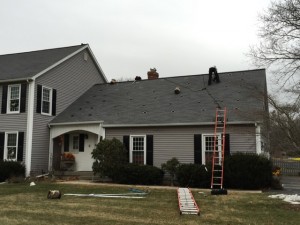 The first order of business was to tape off and secure the area from foot traffic. Anchors are attached to the roof which the crew secured their safety harnesses to.
The first order of business was to tape off and secure the area from foot traffic. Anchors are attached to the roof which the crew secured their safety harnesses to.
Once the precautionary safety measures were in place, the crew began setting up dozens of anchor points across the roof surfaces later to be used as mounting points for the solar panels. That part took most of the first day.
By the end of the first day they had managed to install solar panels on the smaller of the 2 roof lines and had most of the anchors ready on the larger roof line.
Weather Proof Guarantee
A Noreaster hit right in the middle of the week so installation was postponed. To make matter worse, all of the heavy rain and cold weather ended up icing over the roof. I crawled into both attics below each roof to ensure that all of the nails and anchors on the roof didn’t create a leak and was relieved to find that everything was totally dry.
SolarCity guarantees a leak-free installation so it was great to be able to validate that even after torrential rains.
The crew returned on the third day despite the rain and proceeded to work a full day in extremely cold weather and light rain.
Uh oh, Design Challenges
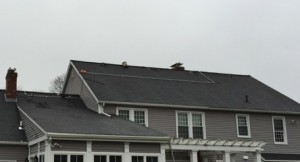 Two different design issues were uncovered during the solar panel installation. The first of which was related to a misjudgment on the number of solar panels that would fit. Designers back at corporate had mapped out 70 panels for the roof, but one of the panels would not fit behind the chimney. The crew offered to stick it somewhere else, but we declined as it would have been asymmetrical anywhere else and the aesthetics would not have been good. So we ended up with a total of 69 panels and a slight decrease in target generation capacity.
Two different design issues were uncovered during the solar panel installation. The first of which was related to a misjudgment on the number of solar panels that would fit. Designers back at corporate had mapped out 70 panels for the roof, but one of the panels would not fit behind the chimney. The crew offered to stick it somewhere else, but we declined as it would have been asymmetrical anywhere else and the aesthetics would not have been good. So we ended up with a total of 69 panels and a slight decrease in target generation capacity.
The second issue was identified on the third day. While the entire install was on the front of the house (thanks to National Grid), they had a pipe running in the middle of the roof on the rear of the house which looked stupid and unnecessary.
I spoke to them about it and they cheerfully redesigned and relocated the entire pipe. In the rain. In 30 degree weather. On top of the house. The install team took our concerns seriously and took care of the problem.
The Final Touches
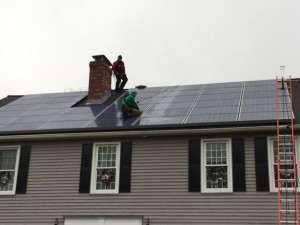 After lugging the panels up all day (each panel weighs about 45 pounds) and mounting them, they took the time to level each of them so they were completely flat.
After lugging the panels up all day (each panel weighs about 45 pounds) and mounting them, they took the time to level each of them so they were completely flat.
At one point a single panel in the middle of the lot was a bit out of place (not perfect) so one of the guys had to slide down the wet, cold, glass on his knees (getting soaked in the process), 30 feet above ground with just a line to keep him safe just to adjust the angle slightly. Those installers are hard core!
Electric Connection
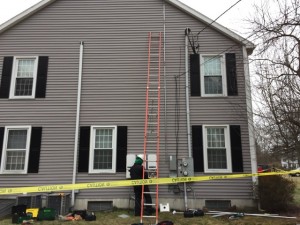 I was surprised that SolarCity needed no access to the house (other than for bathroom breaks) to do the job. The entire connection for my house was on the outside. They needed to cut the power for about 45 minutes to connect into the mains but otherwise there was very little disruption.
I was surprised that SolarCity needed no access to the house (other than for bathroom breaks) to do the job. The entire connection for my house was on the outside. They needed to cut the power for about 45 minutes to connect into the mains but otherwise there was very little disruption.
The size of the installation required 3 inverters which they placed on the side of the house.
Next Steps
The process leading up to the install (3 part series) was frustrating and error-prone between the reluctant power company and the mistakes made by the out-of-touch engineers back at SolarCity corporate. But SolarCity’s installation team was nothing but first class, all the way. They knew their stuff, were very safety conscious and worked through some harsh conditions to get the job done, and done well. They restored my confidence in the decision I made and I’m confident again that things are going to work out well.
Now that the system is installed and ready to go we need to have the inspections done. SolarCity coordinates it all, but there’s a building inspection, an electrical inspection and then an inspection by the power company. Once all passes (in about 3-4 weeks) we’re given the green light to flip the switches and start putting that free energy from the sun to good use.











